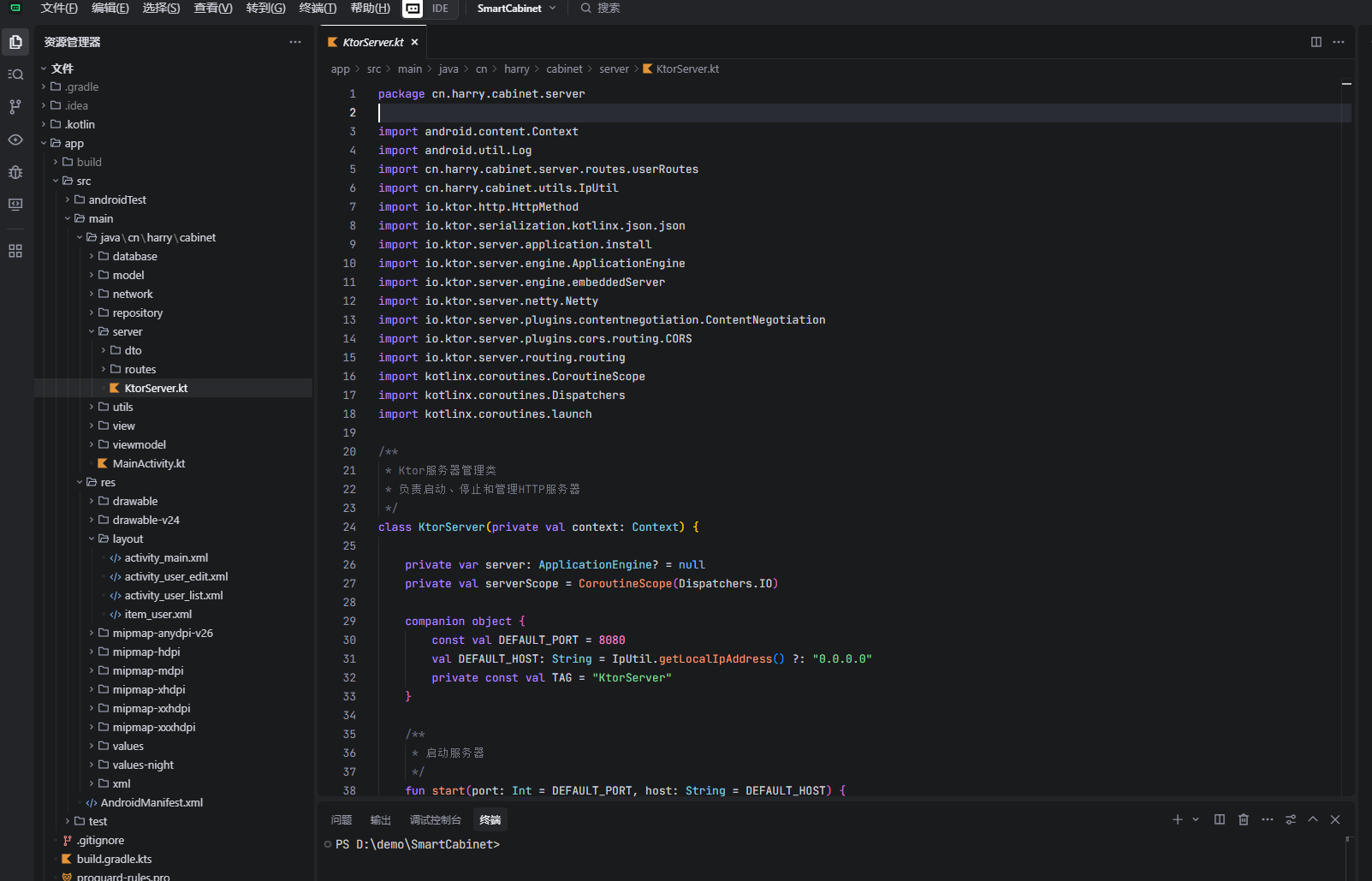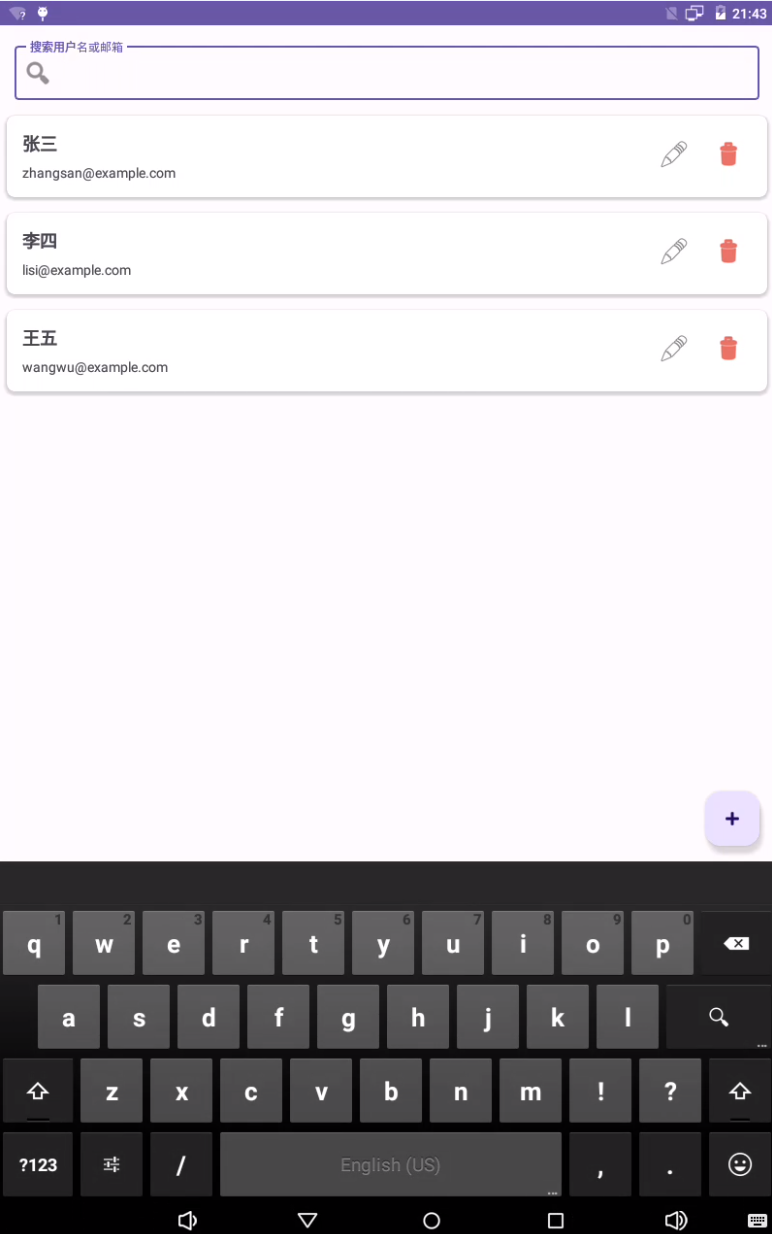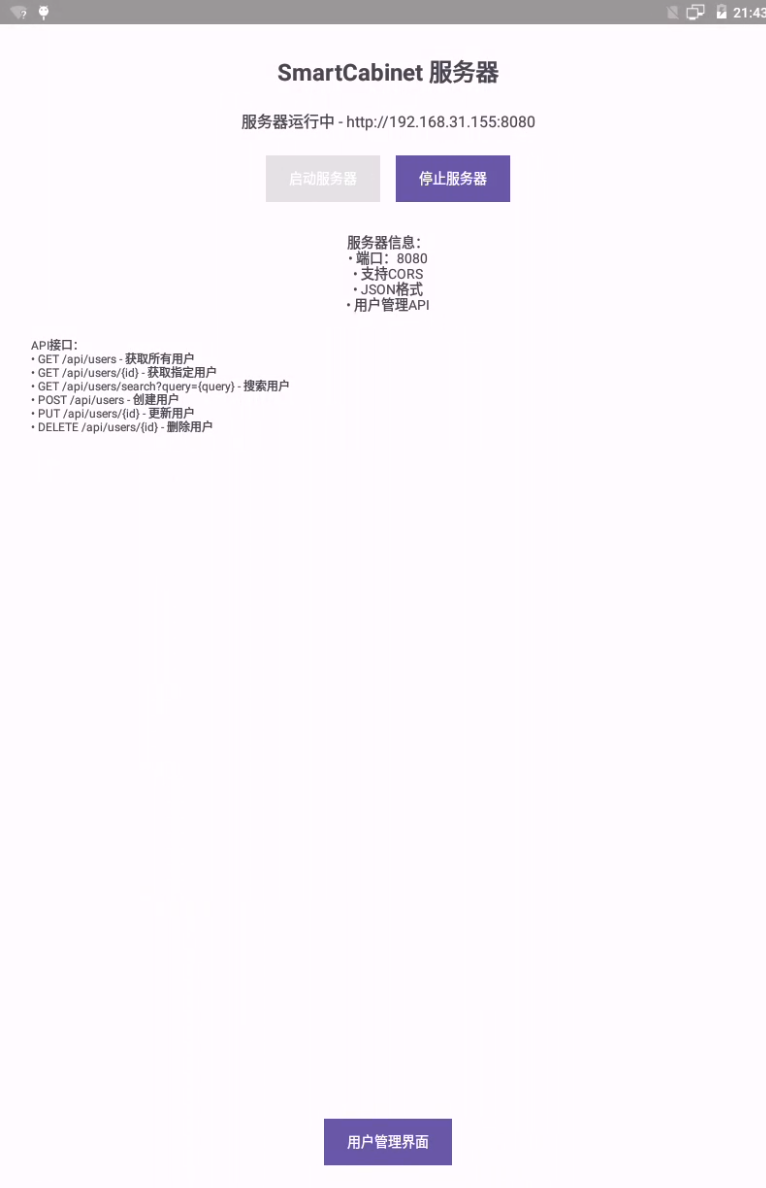Android项目中Ktor的引入与使用实践
引言
在传统的Android开发中,我们通常将Android应用作为客户端,通过HTTP请求与远程服务器进行通信。然而,在某些场景下,我们可能需要将Android设备本身作为服务器,为其他客户 端提供API服务。本文将详细介绍如何在Android项目中引入和使用Ktor框架来实现这一目标。
什么是Ktor?
Ktor是JetBrains开发的基于Kotlin的轻量级框架,用于构建异步的服务器端和客户端应用程序。它具有以下特点:
- 纯Kotlin:完全使用Kotlin编写,充分利用Kotlin的协程特性
- 轻量级:模块化设计,只引入需要的功能
- 异步:基于协程的异步处理,性能优异
- 跨平台:支持JVM、JavaScript、Native等多个平台
项目背景
SmartCabinet是一个智能柜管理系统,采用服务端架构,将Android应用作为HTTP服务器,为其他客户端提供RESTful API接口。这种架构的优势在于:
简化部署:无需额外的服务器部署
本地化:数据存储在本地,隐私性更好
跨平台支持:任何支持HTTP的客户端都可以调用API

Ktor在Android中的引入
1. 依赖配置
在app/build.gradle.kts中添加Ktor相关依赖:
dependencies {
// Ktor Server - 将Android项目作为服务端
implementation("io.ktor:ktor-server-core:2.3.7")
implementation("io.ktor:ktor-server-netty:2.3.7")
implementation("io.ktor:ktor-server-content-negotiation:2.3.7")
implementation("io.ktor:ktor-server-cors:2.3.7")
implementation("io.ktor:ktor-server-auth:2.3.7")
// JSON serialization - Android compatible
implementation("io.ktor:ktor-serialization-kotlinx-json:2.3.7")
implementation("org.jetbrains.kotlinx:kotlinx-serialization-json:1.5.1")
// Logging - Android compatible
implementation("io.github.microutils:kotlin-logging:3.0.5")
implementation("org.slf4j:slf4j-simple:2.0.7")
}
2. 权限配置
在AndroidManifest.xml中添加必要的网络权限:
<uses-permission android:name="android.permission.INTERNET" />
<uses-permission android:name="android.permission.ACCESS_NETWORK_STATE" />
<uses-permission android:name="android.permission.ACCESS_WIFI_STATE" />
<application
android:usesCleartextTraffic="true"
...>
Ktor服务器实现
1. 服务器管理类
创建KtorServer类来管理HTTP服务器的生命周期:
class KtorServer(private val context: Context) {
private var server: ApplicationEngine? = null
private val serverScope = CoroutineScope(Dispatchers.IO)
companion object {
const val DEFAULT_PORT = 8080
val DEFAULT_HOST: String = IpUtil.getLocalIpAddress() ?: "0.0.0.0"
}
fun start(port: Int = DEFAULT_PORT, host: String = DEFAULT_HOST) {
if (server != null) return // 服务器已经在运行
serverScope.launch {
try {
// 配置日志环境
System.setProperty("org.slf4j.simpleLogger.defaultLogLevel", "info")
System.setProperty("org.slf4j.simpleLogger.logFile", "System.out")
server = embeddedServer(Netty, port = port, host = host) {
// 配置CORS
install(CORS) {
anyHost()
allowHeader("*")
allowMethod(HttpMethod.Get)
allowMethod(HttpMethod.Post)
allowMethod(HttpMethod.Put)
allowMethod(HttpMethod.Delete)
allowMethod(HttpMethod.Options)
}
// 配置内容协商
install(ContentNegotiation) {
json()
}
// 配置路由
routing {
userRoutes()
}
}
server?.start(wait = true)
} catch (e: Exception) {
Log.e("KtorServer", "启动Ktor服务器失败: ${e.message}")
}
}
}
fun stop() {
server?.stop(1000, 2000)
server = null
}
fun isRunning(): Boolean = server != null
}
2. 路由定义
使用Ktor的路由系统定义API端点:
fun Route.userRoutes() {
route("/api/users") {
// 获取所有用户
get {
try {
withContext(Dispatchers.IO) {
val users = listOf(
User.createNewUser("张三", "zhangsan@example.com"),
User.createNewUser("李四", "lisi@example.com")
)
val userResponses = users.map { user ->
UserResponse(
id = user.id,
name = user.name,
email = user.email,
createdAt = System.currentTimeMillis()
)
}
call.respond(
HttpStatusCode.OK,
ApiResponse.success(userResponses, "获取用户列表成功")
)
}
} catch (e: Exception) {
call.respond(
HttpStatusCode.InternalServerError,
ApiResponse.errorResponse(500, e.message ?: "未知错误")
)
}
}
// 创建新用户
post {
try {
val request = call.receive<UserCreateRequest>()
if (request.name.isBlank() || request.email.isBlank()) {
call.respond(
HttpStatusCode.BadRequest,
ApiResponse.errorResponse(400, "用户名和邮箱不能为空")
)
return@post
}
withContext(Dispatchers.IO) {
val newUser = User.createNewUser(request.name, request.email)
val userResponse = UserResponse(
id = 1,
name = newUser.name,
email = newUser.email,
createdAt = System.currentTimeMillis()
)
call.respond(
HttpStatusCode.Created,
ApiResponse.success(userResponse, "创建用户成功")
)
}
} catch (e: Exception) {
call.respond(
HttpStatusCode.InternalServerError,
ApiResponse.errorResponse(500, e.message ?: "未知错误")
)
}
}
// 其他CRUD操作...
}
}
3. 数据模型
使用Kotlinx Serialization进行JSON序列化:
@Serializable
data class ApiResponse<T>(
val code: Int,
val message: String,
val data: T? = null
) {
companion object {
inline fun <reified T> success(data: T, message: String = "操作成功"): ApiResponse<T> {
return ApiResponse(200, message, data)
}
fun errorResponse(code: Int, message: String): ApiResponse<Unit> {
return ApiResponse(code, message, null)
}
}
}
@Serializable
data class UserCreateRequest(
val name: String,
val email: String
)
@Serializable
data class UserResponse(
val id: Int,
val name: String,
val email: String,
val createdAt: Long
)
在Activity中使用
在MainActivity中集成Ktor服务器:
class MainActivity : AppCompatActivity() {
private lateinit var ktorServer: KtorServer
private lateinit var serverStatusText: TextView
private lateinit var startServerButton: Button
private lateinit var stopServerButton: Button
override fun onCreate(savedInstanceState: Bundle?) {
super.onCreate(savedInstanceState)
setContentView(R.layout.activity_main)
// 初始化Ktor服务器
ktorServer = KtorServer(this)
// 初始化UI组件
initViews()
setupClickListeners()
updateServerStatus()
}
private fun setupClickListeners() {
startServerButton.setOnClickListener {
startServer()
}
stopServerButton.setOnClickListener {
stopServer()
}
}
private fun startServer() {
try {
ktorServer.start()
updateServerStatus()
} catch (e: Exception) {
serverStatusText.text = "启动服务器失败: ${e.message}"
}
}
private fun stopServer() {
try {
ktorServer.stop()
updateServerStatus()
} catch (e: Exception) {
serverStatusText.text = "停止服务器失败: ${e.message}"
}
}
private fun updateServerStatus() {
val status = ktorServer.getServerInfo()
serverStatusText.text = status
startServerButton.isEnabled = !ktorServer.isRunning()
stopServerButton.isEnabled = ktorServer.isRunning()
}
override fun onDestroy() {
super.onDestroy()
ktorServer.stop()
}
}
API接口使用
基础信息
- 服务器地址:
http://设备IP:8080 - API前缀:
/api - 数据格式:JSON
接口示例
获取所有用户
GET http://192.168.1.100:8080/api/users
创建新用户
POST http://192.168.1.100:8080/api/users
Content-Type: application/json
{
"name": "张三",
"email": "zhangsan@example.com"
}
搜索用户
GET http://192.168.1.100:8080/api/users/search?query=张三

技术要点与最佳实践
1. 协程的使用
Ktor基于协程构建,充分利用Kotlin协程的异步特性:
withContext(Dispatchers.IO) {
// 在IO线程中执行数据库操作
val users = userRepository.getAllUsers()
call.respond(HttpStatusCode.OK, users)
}
2. 错误处理
统一的异常处理机制:
try {
// 业务逻辑
} catch (e: Exception) {
call.respond(
HttpStatusCode.InternalServerError,
ApiResponse.errorResponse(500, e.message ?: "未知错误")
)
}
3. CORS配置
支持跨域请求,便于Web客户端调用:
install(CORS) {
anyHost()
allowHeader("*")
allowMethod(HttpMethod.Get)
allowMethod(HttpMethod.Post)
allowMethod(HttpMethod.Put)
allowMethod(HttpMethod.Delete)
allowMethod(HttpMethod.Options)
}
4. 内容协商
自动处理JSON序列化/反序列化:
install(ContentNegotiation) {
json()
}
常见问题与解决方案
1. 依赖冲突
如果遇到Ktor相关的编译错误:
- 检查网络连接
- 清理Gradle缓存:
./gradlew cleanBuildCache - 确保所有Ktor组件版本一致
2. 网络权限
确保在AndroidManifest.xml中添加了必要的权限:
<uses-permission android:name="android.permission.INTERNET" />
<uses-permission android:name="android.permission.ACCESS_NETWORK_STATE" />
3. 日志配置
避免Logback错误,使用Android兼容的日志库:
System.setProperty("org.slf4j.simpleLogger.defaultLogLevel", "info")
System.setProperty("org.slf4j.simpleLogger.logFile", "System.out")
性能优化建议
1. 线程池配置
根据设备性能调整线程池大小:
embeddedServer(Netty, port = port, host = host) {
// 配置线程池
engine {
threadsCount = 4
}
}
2. 连接池管理
合理配置连接池参数,避免资源浪费。
3. 内存管理
及时释放不需要的资源,避免内存泄漏。
扩展功能
1. 用户认证
集成JWT token认证:
install(Authentication) {
jwt("auth-jwt") {
realm = "Access to the '/api' path"
verifier(JWTConfigurator.SINGLETON_INSTANCE.verifier)
validate { credential ->
if (credential.payload.audience.contains("api")) {
JWTPrincipal(credential.payload)
} else {
null
}
}
}
}
2. API限流
实现请求频率限制,防止滥用。
3. 监控告警
集成健康检查和性能监控。
总结
通过Ktor框架,我们成功地将Android应用转换为HTTP服务器,为其他客户端提供RESTful API服务。这种架构具有以下优势:
- 简化部署:无需额外的服务器基础设施
- 本地化:数据存储在本地,提高隐私性和安全性
- 跨平台:任何支持HTTP的客户端都可以调用API
- 高性能:基于协程的异步处理,性能优异
- 易扩展:模块化设计,便于添加新功能
Ktor在Android中的应用为移动应用开发提供了新的可能性,特别适合需要本地化服务或快速原型开发的场景。通过合理的设计和优化,可以构建出稳定、高效的移动端API服务。
